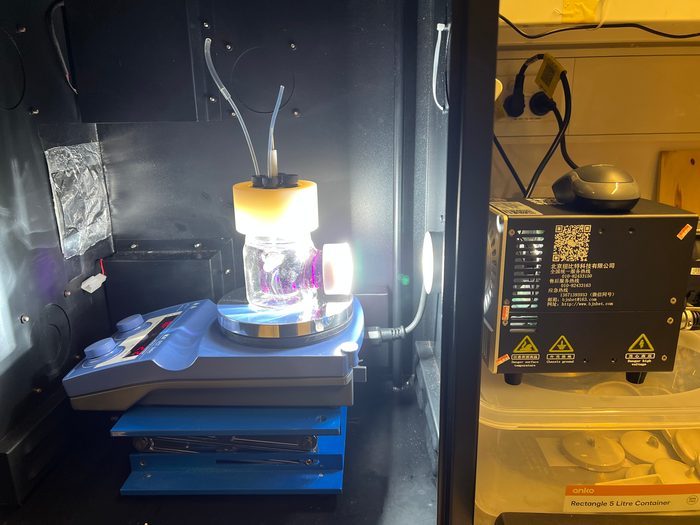When compared with the bulk graphitic carbon nitride, the improved sample had 2.93-fold photocatalytic nitrate reduction to ammonia activity (2.627 mg/h/gcat), and the NH3 selectivity grew from 50.77% to 77.9%.
 Scientists from UTS developed a new method to prepare highly efficient photocatalysts for ammonia synthesis. (Image Credit: An Feng, University of Technology Sydney).
Scientists from UTS developed a new method to prepare highly efficient photocatalysts for ammonia synthesis. (Image Credit: An Feng, University of Technology Sydney).
The researchers published their method in the September 6th issue of the journal Energy Material Advances.
Using everyday stir in green tea solution, certain high-valent irons can be reduced to metals, which may considerably enhance the photocatalytic activity of semiconductors.
Here, waste green tea bags were utilized to reduce the Ru3+, and the photocatalytic activity of the improved sample was 2.93-fold as that of bulk g-C3N4 when exposed to simulated sunlight irradiation, according to corresponding author Bing-Jie Ni, professor at Centre for Technology in Water and Wastewater (CTWW), School of Civil and Environmental Engineering, University of Technology Sydney (UTS).
Currently, ammonia is mainly produced via the Haber process, in which gaseous nitrogen and water gas are converted to ammonia under high temperature and high pressure with the assist of catalysts. Every year, the synthesis of ammonia consumes about 2% of global energy, leading to serious carbon dioxide emission. Thus, it is urgent to develop a green synthesis of ammonia under ambient conditions.
Bing-Jie Ni, Professor and Study Corresponding Author, Centre for Technology in Water and Wastewater, School of Civil and Environmental Engineering, University of Technology Sydney
Ni continued, “Using solar energy to covert nitrate to ammonia is of great significance, as it can not only eliminate the water pollutant, but also synthesize high-value chemicals.”
Ni and his team are involved in the area of renewable energy production, especially the interface between environmental technology and chemical engineering. They concentrate on the incorporation of these disciplines to create advanced and sustainable technological solutions to accomplish efficient energy generation from renewable resources.
However, the reduction of nitrate to ammonia is really challenging in terms of kinetics and thermodynamics, as it is an eight-electron process with multiple steps. Based on experimental and theoretical studies, the introduction of Ru to g-C3N4 can not only boost the light absorption, the adsorption of nitrate, but also accelerate the separation of electron-hole pairs.
Bing-Jie Ni, Professor and Study Corresponding Author, Centre for Technology in Water and Wastewater, School of Civil and Environmental Engineering, University of Technology Sydney
“The thermodynamic energy barrier for the rate determining step in nitrate reduction to the ammonia process is calculated to be less than 0.75 eV, which is much lower than the competing hydrogen generation (0.98 eV) and nitrogen formation (1.36 eV), leading to the preference of generating ammonia,” Ni added.
The results and insights of this study may offer a new platform for the facile and green synthesis of metal particle altered photocatalysts for reducing nitrate to ammonia in the surrounding environment.
Other key contributors include Dr. Jaiwei Ren, Dr. Derek Hao, Prof. Ho Kyong Shon from the Centre for Technology in Water and Wastewater, University of Technology Sydney, as well as A/Prof. Ying Wang affiliated with Changchun Institute of Applied Chemistry, Chinese Academy of Sciences.
This study has been supported by the Australian Research Council Future Fellowship (FT160100195), the National Natural Science Foundation of China (21673220), Department of Science and Technology of Sichuan Province (2017GZ0051), the National Key Research and Development Program of China (2016YFA0602900), and Jilin Province Science and Technology Development Program (20190201270JC, 20180101030JC).
Journal Reference:
Hao, D., et al. (2021) A Green Synthesis of Ru Modified g-C3N4 Nanosheets for Enhanced Photocatalytic Ammonia Synthesis. Energy Material Advances. doi.org/10.34133/2021/9761263.